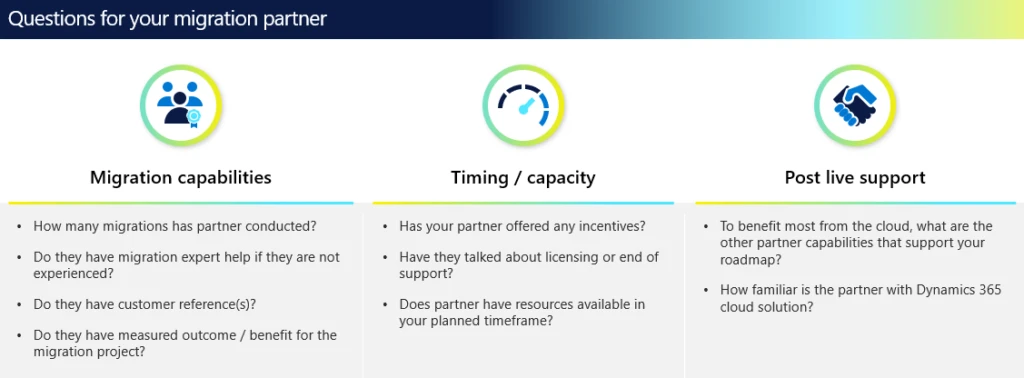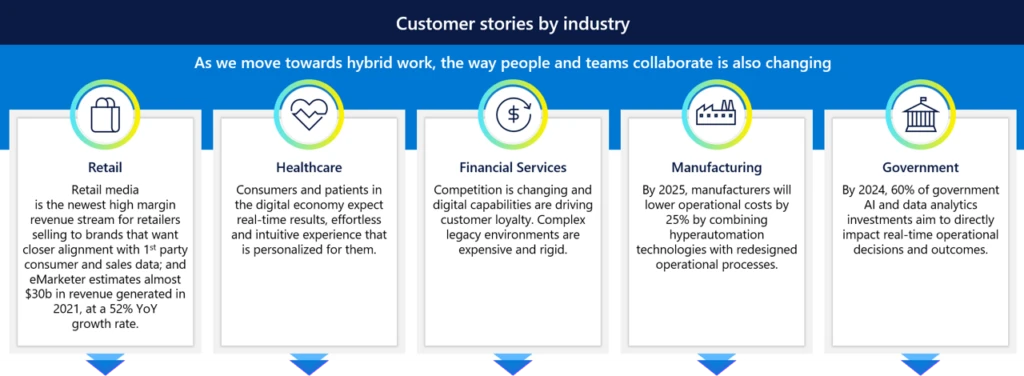
Dynamics 365 drives improvement in manufacturing supply chains
This article is contributed. See the original author and article here.
Microsoft Dynamics 365 is helping manufacturing organizations tackle the challenges they face today while also preparing them for tomorrow’s opportunities. Whether enabling workforce transformation and enterprise resource planning (ERP) modernization, helping navigate disruptions by increasing supply chain visibility and improving insights, or standing up reverse supply chains and circular economieswe are dedicated to helping manufacturers build the resiliency and agility they need to succeed. The following three success stories showcase how our modern, cloud-based, intelligent business applications are driving improvements in manufacturing supply chains.
This embed requires accepting cookies from the embed’s site to view the embed. Activate the link to accept cookies and view the embedded content.
Workforce transformation and ERP modernization
The manufacturing sector has faced labor shortages for some time now, but the pandemic has exacerbated this challenge. This has led many to double down on efforts to utilize technology as a means of offsetting the headwinds caused by ongoing labor shortages.
We see this in manufacturers accelerating workforce transformation of shop floor operations and increasing their utilization of industrial robotics, IoT sensors, AI, and intelligent automation. As these organizations create smarter and more connected factories, they are, in effect, increasing the workforce’s productivity, and this is one means of easing the constraint that labor shortages can have on output.
In addition to easing constraints on labor, manufacturers such as ChemTreat are also benefiting from ERP modernization initiatives. ChemTreat, a water treatment systems company headquartered in Richmond, Virginia, and in business since 1968, was challenged to overcome the limitations of their in-house, custom-coded, desktop-bound ERP system. While the legacy system had served them well for many years, it now required laborious additional workflows, kept data trapped in spreadsheets, and needed nightly downtime. To keep pace with technology changes in the industry and support its growth, the company implemented Dynamics 365 Supply Chain Management.
Today, ChemTreat benefits from real-time, end-to-end supply chain visibility that spans everything from its customers and suppliers to its inventory, expenses, and demand. Direct data visibility is also helping management proactively identify raw material shortages and improve their planning and execution processes. Plus, by modernizing their ERP, ChemTreat has the flexible and composable platform they need to support other digital transformation efforts in the future.
“Dynamics 365 helps us get ahead of challenges, identify potential customer impacts, and determine the best path to the best service.”Katie Journigan, Director of Business Systems, ChemTreat.
Learn more in our blog, Enhance visibility with Dynamics 365 supply chain solutions.
Supply chain visibility and insights
As businesses continue to forge a path out of the pandemic, many find that their current supply chain technologies are ill-equipped for an environment characterized by ongoing disruptions, constraints, and shortages. A recent survey by McKinsey & Company found that successfully implementing AI-enabled supply-chain management has enabled early adopters to improve logistics costs by 15 percent, inventory levels by 35 percent, and service levels by 65 percent, compared with slower-moving competitors.1 This has led to increased investment in advanced supply chain solutions that can connect disparate systems, unify data, increase supply chain visibility, and utilize artificial intelligence to push actionable insights to decision-makers. One company benefiting from investments like these is Daimler Trucks North America (DTNA).
This embed requires accepting cookies from the embed’s site to view the embed. Activate the link to accept cookies and view the embedded content.
DTNA is the leading commercial vehicle manufacturer in the U.S., with a portfolio of distinctive brands like Freightliner and Western Star Trucks. The company has more than 20,000 employees in 91 locations and sources hundreds of thousands of parts from its global supply base. To add to this complexity, DTNA collects data from trucks on the road, its in-house ERP system and supply chain applications, and across its operations and production floor.
Breaking down the siloes of these disparate data sources became necessary for DTNA to meet customer and dealer demand and provide accurate delivery dates. To accomplish this, they needed early visibility into potential time constraints and the ability to collect and share real-time supply chain data with suppliers. With Dynamics 365 Supply Chain Insights, DTNA can make better supply chain decisions with proactive risk mitigation via prescriptive insights powered by AI.
Learn more in our recent blog, Mitigate disruptions with Dynamics 365 Supply Chain Insightsnow in preview.
Reverse supply chains and circular economies
“Sustainability has become an integral part of all world-class supply chains, and circularity is a leading supply chain sustainability strategy that enables recycling and reuse for the majority of a supply chain’s products.” Jodi Larson, General Manager of Strategy and Transformation at Microsoft.
More and more companies are working to make our world sustainable by embracing environmental, social, and governance goals. One way that manufacturing organizations are improving sustainability is by standing up circular economies. Circular economy, or circularity, is rooted in reverse supply chain management, which deals with what happens after a product’s useful life. According to a 2022 report from Gartner, 51 percent of supply chain professionals expect the emphasis on the circular economy to increase in the two years following the COVID-19 crisis.2
As focus ramps up on circular economy strategies, it’s important to understand that reverse supply chain management in manufacturing requires different operational processes. To state the obvious, manufacturers cannot simply accept end-of-life products at existing factories and warehouses. Depending on the complexity of the product and its recoverable raw materials, separate operations are needed to receive, inspect, sort, and refurbish raw materials before they can be reused.
Setting up these circular economy flows can be challenging without an agile and composable supply chain management application. Here at Microsoft, we have first-hand knowledge of the challenges involved as we have recently delivered our first Microsoft Circular Center. The Microsoft Circular Center program is designed to facilitate the reuse and recycling of servers and hardware within our datacenters, which is part of our commitment to achieving zero-waste and carbon-negative operations by 2030.
When planning the pilot of our Circular Center program, we needed a robust and flexible supply chain management platform to support an optimized warehouse routing and processing system to intercept decommissioned servers from Microsoft datacenters. To date, the Circular Centers model has achieved 83 percent reuse and 17 percent recycling of critical parts while contributing to the reduction of carbon emissions by 145,000 metric tons CO2 equivalent.
“We were looking for a warehouse management system that would allow us to model all the product flows that we needed while also connecting to datacenters and other systems used to manage our cloud assets. Dynamics 365 had all of these functionalities to build exactly what we needed.”Anand Narasimhan, General Manager of Cloud Supply Chain Sustainability, Microsoft.
What’s next?
As we have seen through these customer stories, Dynamics 365 drives improvement in manufacturing supply chains by enabling companies to revamp their existing ERP platform, considerably increase supply chain visibility and insights, and stand-up circular economies through reverse supply chain management practices. It also empowers users to plan better, improves organizational agility, and maximizes asset uptime, allowing companies to operate smoothly and profitably.
If you are ready to see what our modern, cloud-based supply chain management solution can do for your organization, we invite you to start today with a free Dynamics 365 trial. You can watch the on-demand webinar on how to create a resilient and sustainable supply chain and the total economic impact of implementing Dynamics 365 Supply Chain Management.
Sources:
1- McKinsey & Company, 2021. Succeeding in the AI supply-chain revolution.
2- Gartner, 2022. Gartner for Supply Chain 3 Key Trends in Supply Chain Sustainability
GARTNER is a registered trademark and service mark of Gartner, Inc. and/or its affiliates in the U.S. and internationally and is used herein with permission. All rights reserved.
The post Dynamics 365 drives improvement in manufacturing supply chains appeared first on Microsoft Dynamics 365 Blog.
Brought to you by Dr. Ware, Microsoft Office 365 Silver Partner, Charleston SC.




Recent Comments